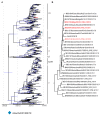Pandemic Risk Assessment for Swine Influenza A Virus in Comparative In Vitro and In Vivo Models
- PMID: 38675891
- PMCID: PMC11053818
- DOI: 10.3390/v16040548
Pandemic Risk Assessment for Swine Influenza A Virus in Comparative In Vitro and In Vivo Models
Abstract
Swine influenza A viruses pose a public health concern as novel and circulating strains occasionally spill over into human hosts, with the potential to cause disease. Crucial to preempting these events is the use of a threat assessment framework for human populations. However, established guidelines do not specify which animal models or in vitro substrates should be used. We completed an assessment of a contemporary swine influenza isolate, A/swine/GA/A27480/2019 (H1N2), using animal models and human cell substrates. Infection studies in vivo revealed high replicative ability and a pathogenic phenotype in the swine host, with replication corresponding to a complementary study performed in swine primary respiratory epithelial cells. However, replication was limited in human primary cell substrates. This contrasted with our findings in the Calu-3 cell line, which demonstrated a replication profile on par with the 2009 pandemic H1N1 virus. These data suggest that the selection of models is important for meaningful risk assessment.
Keywords: animal; epithelial cells; ferrets; humans; influenza A virus; mice; models; pandemics; risk assessment; swine; whole genome sequencing.
Conflict of interest statement
The authors declare no conflicts of interest.
Figures






Similar articles
-
Comparative In Vitro and In Vivo Analysis of H1N1 and H1N2 Variant Influenza Viruses Isolated from Humans between 2011 and 2016.J Virol. 2018 Oct 29;92(22):e01444-18. doi: 10.1128/JVI.01444-18. Print 2018 Nov 15. J Virol. 2018. PMID: 30158292 Free PMC article.
-
Molecular characterization of a novel reassortant H1N2 influenza virus containing genes from the 2009 pandemic human H1N1 virus in swine from eastern China.Virus Genes. 2016 Jun;52(3):405-10. doi: 10.1007/s11262-016-1303-4. Epub 2016 Mar 15. Virus Genes. 2016. PMID: 26980674
-
Evaluation of the zoonotic potential of a novel reassortant H1N2 swine influenza virus with gene constellation derived from multiple viral sources.Infect Genet Evol. 2015 Aug;34:378-93. doi: 10.1016/j.meegid.2015.06.005. Epub 2015 Jun 4. Infect Genet Evol. 2015. PMID: 26051886
-
[Swine influenza virus: evolution mechanism and epidemic characterization--a review].Wei Sheng Wu Xue Bao. 2009 Sep;49(9):1138-45. Wei Sheng Wu Xue Bao. 2009. PMID: 20030049 Review. Chinese.
-
Swine influenza viruses: an Asian perspective.Curr Top Microbiol Immunol. 2013;370:147-72. doi: 10.1007/82_2011_195. Curr Top Microbiol Immunol. 2013. PMID: 22266639 Review.
Cited by
-
Interplay between respiratory viruses and cilia in the airways.Eur Respir Rev. 2025 Mar 19;34(175):240224. doi: 10.1183/16000617.0224-2024. Print 2025 Jan. Eur Respir Rev. 2025. PMID: 40107662 Free PMC article. Review.
References
-
- Garten R.J., Davis C.T., Russell C.A., Shu B., Lindstrom S., Balish A., Sessions W.M., Xu X., Skepner E., Deyde V., et al. Antigenic and genetic characteristics of swine-origin 2009 A(H1N1) influenza viruses circulating in humans. Science. 2009;325:197–201. doi: 10.1126/science.1176225. - DOI - PMC - PubMed
-
- Bakre A.A., Jones L.P., Kyriakis C.S., Hanson J.M., Bobbitt D.E., Bennett H.K., Todd K.V., Orr-Burks N., Murray J., Zhang M., et al. Molecular epidemiology and glycomics of swine influenza viruses circulating in commercial swine farms in the southeastern and midwest United States. Vet. Microbiol. 2020;251:108914. doi: 10.1016/j.vetmic.2020.108914. - DOI - PubMed
Publication types
MeSH terms
Grants and funding
LinkOut - more resources
Full Text Sources
Medical

